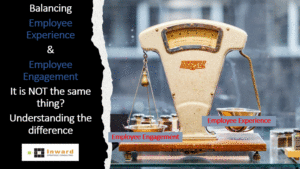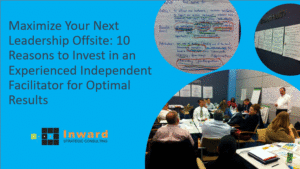The Balancing Act Between Employee Experience & Employee Engagement. They are not the same thing!
The terms “employee experience” and “employee engagement” are often used interchangeably in discussions surrounding the workplace and organizational culture. However, they represent distinct concepts that have a significant impact on employee satisfaction, productivity, and overall well-being. Understanding the difference between these two notions is crucial for organizations seeking to create a positive work environment and maximize employee potential.
Employee Experience
Employee experience refers to the sum total of all interactions an employee has with their organization throughout their journey, from the initial recruitment process to their daily work activities, and even beyond their departure. It encompasses the physical, emotional, and cultural aspects of the work environment and includes elements such as workplace design, company values, leadership style, communication channels, and overall organizational support.
Employee Engagement
On the other hand, employee engagement specifically focuses on the level of commitment, passion, and dedication an employee has toward their work and the organization. It measures the extent to which employees are willing to invest their discretionary effort and go above and beyond their prescribed duties. Engaged employees are more likely to be motivated, and innovative, and deliver high-quality results. Factors that contribute to employee engagement include meaningful work, opportunities for growth and development, clear expectations, recognition and rewards, and a supportive work environment.
Balancing Act
While employee engagement is an essential component of the employee experience, it is just one aspect of the broader picture. Employee experience takes a more holistic approach by considering the entire employee lifecycle and the various touchpoints an employee encounters throughout their journey. It recognizes that employees are not solely driven by their level of engagement, but also by the quality of their work environment, the relationships they form with colleagues and managers, the resources and support available to them, and the alignment between their personal values and those of the organization.
Organizations that prioritize employee experience understand that engagement alone is not enough to create a thriving workforce. They recognize that employees’ satisfaction, well-being, and sense of belonging are equally important. By investing in creating a positive employee experience, organizations can cultivate a culture of trust, authenticity, and inclusivity, which in turn boosts employee engagement.
Improving the employee experience involves taking a proactive approach to understanding employees’ needs, expectations, and pain points. This can be achieved through regular feedback surveys, focus groups, and open communication channels. By listening to employees and acting upon their feedback, organizations can identify areas for improvement and implement changes that enhance the overall employee experience. This may involve revising policies, providing better training and development opportunities, promoting work-life balance, or fostering a sense of purpose and meaning in the work employees do.
The relationship between employee experience and employee engagement is reciprocal, with each influencing the other in a continuous feedback loop. While it is challenging to determine which factor has a greater influence, it can be argued that employee experience lays the foundation for employee engagement.
While it is challenging to determine which factor has a greater influence, it is crucial to recognize that both employee experience and employee engagement are essential for a thriving workforce and organizational success. Organizations need to invest in creating a positive employee experience that fosters engagement, and simultaneously, they should focus on engaging their employees to enhance the overall experience. It is a symbiotic relationship where the two factors reinforce and strengthen each other.
Companies can invest in employee experience and employee engagement effectively by implementing the following strategies:
- Foster a Positive Work Culture: Cultivate a positive work culture that values open communication, collaboration, and respect. Encourage employees to share their ideas, opinions, and concerns freely. Promote a sense of belonging and inclusion by celebrating diversity and providing equal opportunities for growth and advancement.
- Prioritize Employee Well-being: Invest in programs and initiatives that support employee well-being, both physical and mental. Offer wellness programs, flexible work arrangements, and work-life balance policies. Provide resources and support for stress management, mental health, and overall employee wellness.
- Enhance Leadership and Management Skills: Train managers and leaders to be effective communicators, mentors, and coaches. Provide them with the skills and tools to support and empower their teams. Strong leadership that promotes trust, transparency, and accountability is crucial for creating a positive employee experience and fostering engagement.
- Provide Growth and Development Opportunities: Offer employees opportunities for learning, skill development, and career advancement. Implement training programs, mentorship initiatives, and performance feedback mechanisms. Encourage employees to set and pursue meaningful goals that align with their personal and professional aspirations.
- Recognize and Reward Employee Contributions: Implement recognition and reward programs to acknowledge and appreciate employee achievements and contributions. Recognize both individual and team efforts. Celebrate milestones, achievements, and exceptional performance to foster a sense of accomplishment and motivation.
- Create a Positive Physical Work Environment: Design a workspace that promotes productivity, creativity, and collaboration. Provide ergonomic facilities, comfortable workstations, and spaces for relaxation and socialization. Consider the aesthetics, lighting, and overall ambiance to create a pleasant and inspiring work environment.
- Solicit and Act on Employee Feedback: Regularly seek feedback from employees through surveys, focus groups, or one-on-one discussions. Act on the feedback received by addressing concerns, implementing suggestions, and communicating the progress made. Demonstrating that employee voices are heard and valued fosters a sense of ownership and engagement.
- Align Organizational Values with Employee Values: Ensure that the organization’s values align with those of the employees. Clearly communicate the company’s mission, vision, and core values. Involve employees in shaping and reinforcing these values to create a shared sense of purpose and direction.
- Encourage Collaboration and Teamwork: Foster a collaborative work environment that encourages teamwork, knowledge sharing, and cross-functional collaboration. Provide platforms and tools that facilitate communication and collaboration among employees, regardless of their roles or departments.
- Lead by Example: Leadership plays a crucial role in shaping the employee experience and promoting engagement. Leaders should exemplify the desired values, behaviors, and attitudes. By leading by example, they inspire and motivate employees to give their best and contribute positively to the organization.
By focusing on all these aspects, organizations can create a virtuous cycle. A positive employee experience increases employee engagement, leading to higher productivity, retention, and innovation. Engaged employees, in turn, contribute to a positive work environment and the overall experience of their colleagues, creating a culture that attracts and retains top talent.
In summary, employee experience and employee engagement are closely intertwined but represent distinct concepts. While employee engagement measures the level of commitment and passion employees have towards their work, employee experience encompasses the broader aspects of the work environment and the overall journey of employees within the organization. Prioritizing both employee engagement and employee experience is essential for creating a positive and fulfilling work environment that nurtures employee potential, enhances productivity, and drives organizational success.

































